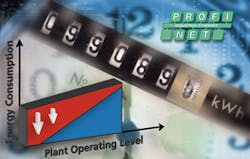PI Develops Energy-Saving Profile Based on PROFINET
The high cost of energy, the downturn in the global economy, and the need to comply with legal regulations have created a perfect storm for manufacturers worried about energy management. While manufacturing companies have been taking stronger measures to reduce energy costs for several years, PI (PROFIBUS & PROFINET International) is tackling energy savings head-on by defining and standardizing a manufacturer-independent energy-saving profile based on PROFINET. This issue is of special interest in meeting other manufacturing goals, such as resource preservation and reduction of production times, which can be achieved by skillfully introducing energy-saving measures.The PI effort was requested by the Automation Initiative of German Automobile Manufacturers (AIDA), whose companies use PROFINET in their systems. AIDA has tasked PI with providing functions and mechanisms for PROFINET that support energy-efficient production.Specifically, PI will create an energy-saving profile based on PROFINET, called “PROFIenergy,” that addresses the need to reduce carbon dioxide emissions, reduce electrical energy consumption, and manage energy usage without hampering the production process. A “profile” documents consistent ways for the base communications technology of PROFINET to move information. (Other frequently used profiles are PROFIsafe and PROFIdrive.)In February 2009, PI formed a special working group to begin specification work and definition of use cases and requirements from the end-user’s perspective. The solution stipulates the definition of different energy saving modes for various devices. Using the energy saving profile, the energy saving modes of the devices can be addressed uniformly and easily by a programmable logic controller (PLC) and their responses can be evaluated. This allows a system controller to utilize optimum energy consumption during production and during the various break lengths. Defining Use CasesThe working group has defined four use cases for energy management.• Use Case 1: Disconnection and connection during pauses• Use Case 2: Disconnection and connection on the weekend• Use Case 3: Load-dependent machine control• Use Case 4: Pausing auxiliary process under threat of load spikeBecause it’s based on standard PROFINET, the energy-saving profile can be integrated into individual components and devices without requiring new hardware. In addition to PLCs, equipment covered by the profile includes robots, human-machine interfaces (HMIs), lasers, device controllers (e.g. motor starters and frequency converters) and manufacturing subsystems, such as a portable welding box, among other devices.As well as defining the use cases, the working group has identified the requirements of the end-user. These fall under three broad categories:• Usability—Users want the same behavior of the devices during parameterization, runtime and diagnosis• Wide support from device manufacturers, to maximize device choices and achieve higher energy savings• Standardization of the profile by PIPI has committed to have the PROFIenergy energy-saving profile available to the market by the end of 2009, when it can be implemented by device manufacturers and deployed by end users to realize energy management savings.

